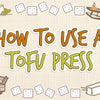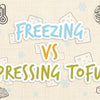Freezing vs Pressing tofu

Pressing tofu is a great way to improve its texture by draining the excess water content. You can also go an extra step in this process by freezing the tofu and thawing it before pressing the block. This is made possible by the fact that tofu is roughly 85% water, which expands upon freezing. The ice crystals that form around the soy extract end up creating tiny pockets, and when the tofu gets thawed, the ice melts and drains out when pressed, leaving behind a spongier and porous tofu block that’s chewy and more absorbent.
While it takes more time to prepare frozen tofu, the results are arguably worth the effort as the tofu gains a ‘meatier’ texture that absorbs more marinades and flavor through seasoning. Let’s take a detailed look into everything you need to know about freezing and pressing tofu.
Should You Freeze Tofu?

You should definitely freeze your store-bought tofu to increase its shelf life for months while improving its texture. When frozen, the water in the block forms ice crystals, which change the original structure by creating tons of tiny coral reef-like holes in the tofu, making it spongier when the ice crystals thaw. Frozen tofu is often much easier to press after thawing as the water easily drains out, leaving behind a denser tofu block with a distinct consistency that easily soaks up marinades.
Freezing vs. Pressing Tofu

The choice of whether to freeze your tofu or simply skip the press and go directly to pressing it is often dictated by how much time you have to prepare the tofu meal and the type of tofu you are dealing with. Just like you cannot press silken tofu, you also cannot freeze it, as it will lose its silky texture.
Freezing tofu removes more water content from the tofu block compared to just pressing it. This, in turn, leads to improved texture and taste changes in the frozen tofu, making it perfect for stir-fries. On the other hand, if you have limited prep time, simply slicing a firm or extra firm block of tofu and using a tofu press will deliver consistent results without the extra time required for freezing and thawing tofu.
How to Freeze Tofu

You can easily make frozen tofu at home using store-bought tofu. Here are the instructions:
- Drain the tofu. Remove your block or package of tofu from its packaging and drain off any excess water. You can do this by placing the tofu on a plate angled over the sink or gently pressing it between layers of paper towels.
- Cut the tofu. You may want to cut the tofu into smaller slices or cubes before freezing for better water release. This exposes more surface area. Slice or cube the tofu into your desired shape and size.
- Line a baking sheet with paper towels. Place a layer of paper towels on a baking sheet or plate and arrange the cut tofu pieces in a single layer on top. Cover with another layer of paper towels.
- Press out excess water. Gently press down on the layers of paper towels to soak up any water leaking from the tofu. Let sit for 5-10 minutes before removing paper towels.
- Transfer to freezer bags or airtight containers. Place the drained tofu pieces into freezer bags or an airtight container, making sure not to overcrowd them. Remove excess air from bags before sealing.
- Freeze overnight. Place the tofu in the freezer and freeze overnight or for at least 12-24 hours. Frozen tofu will keep for several months.
- Thaw before using. When ready to use, thaw the frozen tofu in the refrigerator overnight. Use within a few days. Once thawed, excess water will drain from the tofu.
Tips for freezing tofu

- Freezing in smaller pieces makes for quick thawing.
- Use extra firm or firm tofu varieties for best results.
- Store frozen tofu flat in the freezer to prevent breaking when frozen.
- Refrain from freezing tofu too long, or it will become overly spongy in texture.
Benefits of freezing tofu

The ice crystals that form within the tofu during freezing cause the dense soy protein structures to separate and become porous. This gives frozen tofu a spongy, almost styrofoam-like texture when thawed. The protein strands become stretchier too.
The chewier, meatier texture works very well in place of meat in stir-fries, battered and fried tofu, crumbles, etc. Fresh tofu has a smoother, more delicate texture in comparison. Freezing transforms the texture dramatically.
2. Expels more moistureThe ice crystals that perforate the tofu allow much of the moisture to drain out upon thawing. Pressing fresh tofu may remove surface moisture, but freezing pulls water from deep within the tofu block.
Thawed frozen tofu has a drier, almost spongy structure with much fewer water droplets throughout. This gives it a firmer, denser texture and reduces the need for pressing thawed tofu.
3. Intensifies the flavorWith less moisture content, the soy flavor of tofu becomes more concentrated after freezing. The pores create more surface area for marinades and sauces to permeate into. Frozen tofu is able to absorb more seasoning, giving it more flavor punch.
4. Improves shelf lifeWhen frozen and properly stored, tofu can last 6-8 months in the freezer versus just 4-7 days when fresh. The frozen state preserves the proteins and prevents bacterial growth and spoilage. Thawed frozen tofu should be used within a few days but can be refrozen once if needed, albeit the texture will degrade the next time you thaw the refrozen tofu.
5. Easier to useFrozen tofu is ready to use straight from the freezer - just thaw overnight in the fridge. Unlike with fresh tofu, there is no need to wrap and press out moisture before using it. The texture changes make crumbling and pan-frying easier as well.
Drawbacks of freezing tofu

- Freezing tofu can make it slightly crumbly. This is especially the case if you are dealing with silky varieties.
- Frozen tofu may not absorb marinades as well as fresh tofu if you don't let the ice thaw and drain out.
Should you press previously frozen tofu?

You do not need to press frozen tofu before using it. Freezing tofu helps to remove some of the water content, which can make it firmer and more absorbent. However, pressing frozen tofu will not remove more water than freezing it does, so it is unnecessary.
In fact, pressing frozen tofu makes it more crumbly. This is because the ice crystals that form during freezing can break down the tofu's structure. If you want to press frozen tofu, it is best to do so after it has thawed.
How to press previously frozen tofu

If your frozen tofu is still not firm enough, even after thawing, you attempt to press it, although the results will vary greatly depending on the type of tofu you are dealing with and how long it was previously frozen. Follow these steps if you are looking to press previously frozen tofu:
1. Thaw the tofu block completelyIt's important to thaw frozen tofu fully before pressing to avoid crumbling the tofu. Leave the frozen tofu block sealed in its package and thaw in the refrigerator for 12-24 hours. Thawing at room temperature runs the risk of bacterial growth on the surface.
2. Drain excess liquidOnce fully thawed, open the package and pour off any water that has accumulated. Excess moisture is released as the tofu thawed, and draining it off prevents soggy pressing.
3. Let the thawed tofu block rest before pressing.Freshly thawed tofu is very delicate and prone to crumbling if handled roughly. After draining, let the tofu sit on the counter for 5-10 minutes before wrapping for pressing. This short rest allows the texture to firm up slightly and makes pressing easier. Remember to use a light touch when lifting out of the package to avoid breaking it.
4. Lightly wrap the thawed tofu.Use paper towels or a towel to lightly enclose tofu before weighing, as tofu straight from the freezer should not be squeezed or tightly wrapped. Instead, Use paper towels or a towel to lightly enclose tofu before weighing.
5. Start pressing with light weights.Place a small pan or plate on top of the wrapped tofu at first. Keep in mind that too much weight right away can make the delicate tofu crumble, so go slow. Gradually increase weight after 10 to 15 minutes by adding another pan or plate building up to heavier weights, which will give the tofu block time to adjust and prevent it from crumbling.
6. Flip the tofu block halfway.In order to evenly press moisture from the tofu block, you should gently flip it about halfway through the process. Avoid over-pressing tofu; typically, the entire process should last up to 30 minutes as it can make the tofu dry and crumbly.
7. Unwrap and use promptlyOnce you are done pressing the tofu block, gently unwrap it and use it immediately in recipes. Avoid re-freezing after pressing, as the tofu block might not hold its shape the next time you thaw it again.
Conclusion

Freezing tofu takes more time, but it can give the tofu a spongy texture, which makes it more absorbent. On the other hand, pressing tofu is quicker and easier, but the texture improvement may vary depending on the type of tofu press you used and how long you pressed the tofu. Ultimately, the best method for pressing or freezing tofu depends on your needs and preferences. If you are looking for a quick way to make firm tofu and improve its absorbency, then pessing is a good option. On the other hand, if you are looking for an easy way to preserve tofu while also draining it, then freezing is the best choice for you.






